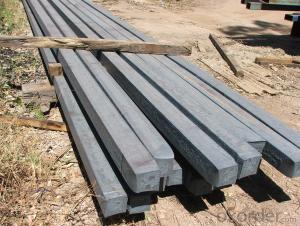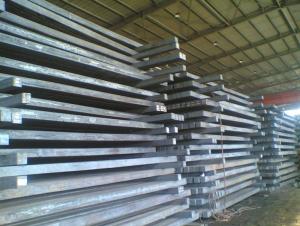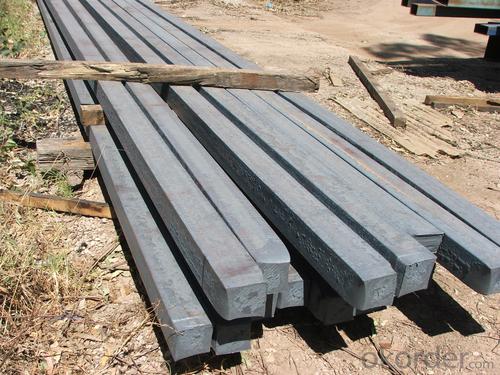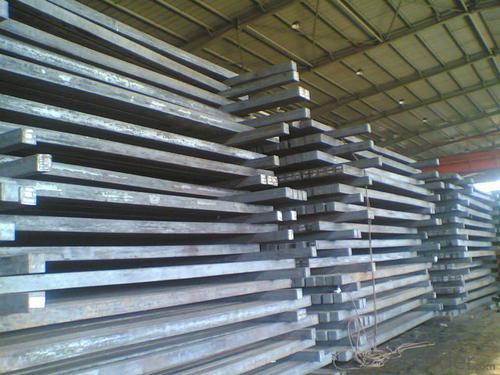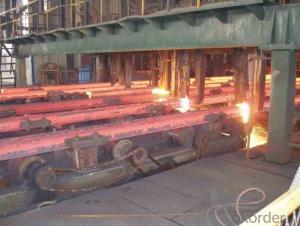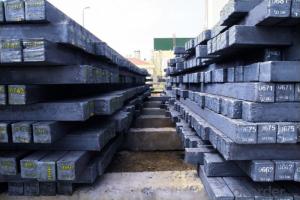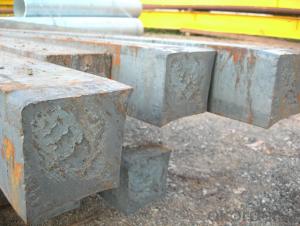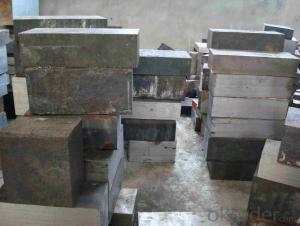Prime quality square alloy steel billet 170mm Q235
- Loading Port:
- Tianjin
- Payment Terms:
- TT OR LC
- Min Order Qty:
- 100 m.t.
- Supply Capability:
- 10000 m.t./month
OKorder Service Pledge
OKorder Financial Service
You Might Also Like
Structure of Prime quality square alloy steel billet 170mm Q235
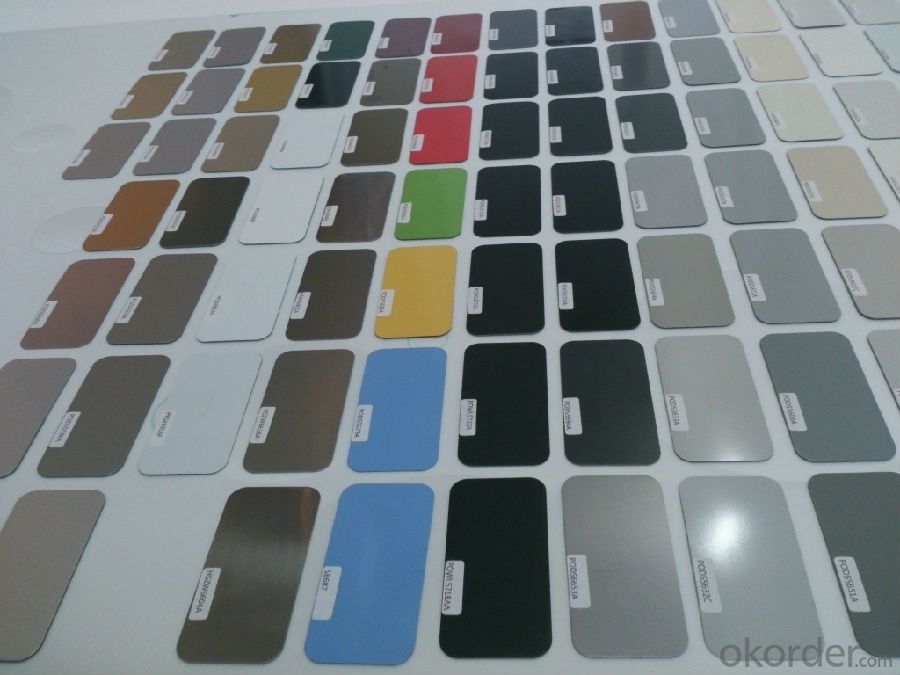
Description of Prime quality square alloy steel billet 170mm Q235
1. Prepainted steel coil is coated with organic layer, which provides higher anti-corrosion property and a longer lifespan than that of galvanized or galvalume steel sheets.
2. The base metals for prepainted steel coil consist of cold rolled, HDGI Steel, electro-galvanized and hot-dip alu-zinc coated steel. The finish coats of prepainted steel coil can be classified into groups as follows: polyester, silicon modified polyesters, polyvinylidene fluoride, high-durability polyester, etc.
3. The production process has evolved from one-coating-and-one-baking to double-coating-and-double-baking, and even three-coating-and-three-baking.
4. The color of the prepainted steel coil has a very wide selection, like orange, cream-colored, dark sky blue, sea blue, bright red, brick red, ivory white, porcelain blue, etc.
5. The prepainted steel coils can also be classified into groups by their surface textures, namely regular prepainted sheets, embossed sheets and printed sheets.

Main Feature of Prime quality square alloy steel billet 170mm Q235
Uncoated CR steel sheet
With the features of in line with the international highest standards in demension and shape, excellent surface finish and properties, the products are mainly used in home appliance and automobile industries.
Galvanized steel sheet(include HDG and EG)
With the features of good corrosion resistance, the products are mainly used in automobile, home appliance, electronics, building and machinery manufacture industries, etc.
Precoated steel sheet
With the features of enviromental protection and good processablility, long lasting surface durability, rich in colors, the products are maily used in building, home appliance and furniture industries, etc.
Applications of Prime quality square alloy steel billet 170mm Q235
Construction
Manufacture anticorrosion, industrial and civil architecture roof boarding, roof grille
Light industries
Home appliance's case, civil chimney, kitchen utensils
Auto industry
Corrosion resistant parts of cars
Agriculture
Food storage, meat and aquatic products' freezing and processing equipment
Commerce
Equipments to store and transport materials, and packing implements

Specifications of Prime quality square alloy steel billet 170mm Q235
Product | Prime quality square alloy steel billet 170mm Q235 |
Material Grade | SGCC / SGCH / DX51D+AZ, etc |
Thickness | 0.6-3.0mm |
Width | 500-1500mm |
Tolerance | Thickness: +/-0.02mm , Width:+/-2mm |
Zinc-coating | Z30-150g/m2 |
Technique | Raw material: Hot rolled steel coil --> Cold rolled_>hot dipped galvalume |
Surface | Dried, Chromated, Unoiled |
Spangle | Regular spangle , small spangle, zero spangle |
ID | 508MM 610MM |
Coil weight | 1-25MT |
Export package | Cardboard inner sleeves, Waterproof paper, galvanized steel covered and steel strip packed |
FAQ of Prime quality square alloy steel billet 170mm Q235
We have organized several common questions for our clients,may help you sincerely:
1. How Can I Visit There?
Our company is located in Tianjin City, China, near Beijing. You can fly to Tianjin Airport Directly. All our clients, from home or aboard, are warmly welcome to visit us!
2. How Can I Get Some Sample?
We are honored to offer you sample.
3. Why choose CNBM?
Our delivery time about 15-20days for standard sizes, if you have other requirements like hardness, quanity and width ,it is about 20-40days. But don't worry we also try our best for the delivery time ,because time longer and our cost is higher.
- Q: What is the role of steel billets in the construction of power plants?
- The construction of power plants relies heavily on steel billets, which are semi-finished steel products utilized as raw materials in various processes involved in power plant production. A significant application of steel billets in this field is the creation of structural steel, which forms the framework of power plant structures like the main building, turbine halls, reactor buildings, and cooling towers. To produce the necessary structural components such as beams, columns, and trusses, steel billets are melted, refined, and cast into different shapes and sizes. These components provide essential support and stability to power plant infrastructure. Furthermore, steel billets are crucial in the manufacturing of equipment and machinery necessary for power generation. Turbine rotors, generator frames, and condensers are among the components produced using steel billets. These components play a vital role in the operation of power plants and contribute to efficient energy conversion. Moreover, steel billets are utilized in the construction of storage tanks, pipelines, and ducts within power plants. These structures are crucial for storing and transporting various fluids like water, steam, and fuel. Steel billets are transformed into sheets, plates, and tubes to fabricate these components, which are designed to withstand high pressures and temperatures. Steel billets are also highly durable and possess exceptional mechanical properties such as strength and toughness. These properties enable them to withstand the harsh operating conditions and loads experienced in power plants. They can endure high temperatures, corrosion, and stresses, ensuring the structural integrity and longevity of power plant infrastructure. In conclusion, steel billets are indispensable in power plant construction as they are employed in the production of structural components, equipment, and machinery. Their durability, strength, and versatility make them the preferred material in this industry. The use of steel billets guarantees the reliability and safety of power plants, ultimately contributing to the generation of electricity for various industries and communities.
- Q: How do steel billets contribute to the overall sustainability of a structure?
- There are several ways in which steel billets are crucial for enhancing the overall sustainability of a structure. Firstly, steel is a highly durable material with a long lifespan. This means that structures built with steel billets will have a longer service life and require fewer replacements or repairs. Consequently, the consumption of resources and materials needed for construction is reduced, resulting in minimized waste and conserved energy. Moreover, steel is 100% recyclable, allowing the steel billets to be easily recovered and reused for other purposes at the end of a structure's lifespan. Compared to producing steel from raw materials, recycling steel requires significantly less energy. As a result, greenhouse gas emissions are reduced, and carbon footprints are lower. This approach of a circular economy helps conserve resources and reduces the demand for new steel production, which has a significant environmental impact. Furthermore, steel billets contribute to the overall sustainability of a structure through their strength and versatility. With a high strength-to-weight ratio, steel can support heavy loads with less material, leading to more efficient designs and reduced material consumption. This not only conserves resources but also decreases the carbon emissions associated with the transportation and delivery of steel. Additionally, steel is a non-combustible material, offering structures built with steel billets greater resistance to fires. This enhances the safety and resilience of the structure, reducing the risk of damage or collapse during unforeseen events. Furthermore, the use of steel in structures can contribute to energy efficiency by providing a thermal mass that retains and releases heat, reducing the need for excessive heating or cooling. In conclusion, through their durability, recyclability, strength, and non-combustible properties, steel billets significantly contribute to the overall sustainability of a structure. By incorporating steel into construction, we can minimize waste, conserve resources, reduce carbon emissions, enhance safety, and improve energy efficiency. This ultimately makes structures more environmentally friendly and sustainable in the long run.
- Q: How are steel billets heat-treated?
- Steel billets are typically heat-treated through a process called annealing, which involves heating the billets to a specific temperature and then slowly cooling them. This helps to relieve any internal stresses and improve the overall strength and ductility of the steel.
- Q: What are the different forming processes used for steel billets?
- There are various methods for forming steel billets, each possessing unique advantages and applications. These methods encompass: 1. Casting: This process involves the pouring of molten steel into a mold for solidification. It is commonly employed for large-scale steel billet production, as it allows for the creation of intricate shapes and sizes. However, casting may result in surface defects and necessitate additional finishing procedures. 2. Extrusion: The extrusion process entails the forceful passage of a steel billet through a die to achieve a desired shape. It is frequently used to fabricate long, uniform sections like bars, rods, and tubes. Extrusion ensures high precision and superior surface finish, rendering it suitable for applications where dimensional accuracy is crucial. 3. Rolling: Rolling is a widely utilized method for shaping steel billets. It involves passing the billet through a set of rollers to decrease its cross-sectional area and increase its length. Rolling can be carried out at high or low temperatures, depending on the desired properties of the final product. This versatile and cost-effective process can produce an extensive range of shapes, including flats, rounds, and squares. 4. Forging: Forging is a technique in which a steel billet is heated and shaped through compressive forces. This process is renowned for generating robust, durable components with exceptional mechanical properties. Forging can be executed via various methods such as open-die forging, closed-die forging, and press forging. It is commonly employed for manufacturing high-strength parts like gears, crankshafts, and connecting rods. 5. Swaging: Swaging is a process that involves reducing the diameter of a steel billet by forcefully pushing it through a series of dies. It is frequently employed for shaping tubular sections such as pipes and tubes. Swaging guarantees high accuracy and tight tolerances, making it suitable for applications that require precise fitting or specific diameters. 6. Drawing: Drawing is a process in which a steel billet is pulled through a die to decrease its cross-sectional area while increasing its length. It is commonly used for producing wires, cables, and thin tubes. Drawing ensures excellent surface finish and dimensional accuracy, making it suitable for applications that demand fine wire or precise tubing. Each of these forming processes possesses distinct advantages and is chosen based on the specific requirements of the application at hand.
- Q: How are steel billets used in the production of automotive suspension components?
- Steel billets are used in the production of automotive suspension components by being heated and then shaped into the desired form, such as rods or bars, which are then further processed and machined to create various suspension parts like control arms, tie rods, and sway bars. The high strength and durability of steel billets make them ideal for withstanding the heavy loads and extreme conditions experienced by suspension components in vehicles.
- Q: Are steel billets subject to any international standards?
- Steel billets must adhere to international standards, as set by the International Organization for Standardization (ISO). These standards govern the production, quality, and dimensions of steel billets, guaranteeing that they meet specific criteria and are suitable for use in various industries, including construction, manufacturing, and engineering. ISO standards like ISO 683-2 and ISO 16143-1 outline guidelines for the chemical composition, mechanical properties, and tolerances of steel billets. Moreover, international trade organizations such as the International Trade Commission (ITC) and the World Trade Organization (WTO) may also establish regulations and standards for the import and export of steel billets to ensure equitable trade practices and product safety. Consequently, to ensure uniformity, quality, and compliance across different countries and markets, steel billets are subject to international standards.
- Q: How are steel billets used in the manufacturing of aerospace components?
- Steel billets are used in the manufacturing of aerospace components as they provide a crucial starting material for the production of various parts. These billets, which are essentially semi-finished steel products in the shape of a square or rectangular solid, undergo a series of processes to transform them into the required aerospace components. Firstly, steel billets are subjected to a heating process known as "hot working." This involves heating the billets to high temperatures, typically around 1200-1300°C, to make them more malleable and easier to shape. The heated billets are then passed through a series of rolling mills, where they are gradually reduced in size and shaped into the desired forms, such as bars, rods, or sheets. Once the steel billets are transformed into the desired shapes, they are further processed through various techniques like forging, extrusion, or machining to create specific aerospace components. For example, the billets can be forged or machined to produce critical parts like engine shafts, landing gear components, or structural supports. The use of steel billets in aerospace manufacturing offers several advantages. Steel is known for its high strength, durability, and excellent mechanical properties, making it an ideal material for aerospace applications. Steel components can withstand extreme conditions, such as high temperatures and pressures, as well as resist corrosion and fatigue, ensuring the safety and reliability of aerospace systems. Moreover, steel billets can be customized to meet the stringent requirements of aerospace components. By carefully controlling the composition, heat treatment, and manufacturing processes, steel billets can be tailored to provide specific properties, such as high strength-to-weight ratio, excellent heat resistance, or improved fatigue life. This customization ensures that the resulting aerospace components meet the demanding standards of the industry. In conclusion, steel billets play a vital role in the manufacturing of aerospace components. Through a series of heating, shaping, and processing techniques, steel billets are transformed into various forms that are then further processed to create critical aerospace parts. The use of steel as a material offers exceptional strength, durability, and customization possibilities, ensuring the production of high-quality and reliable aerospace components.
- Q: How are steel billets inspected for defects?
- Steel billets are inspected for defects through a series of thorough and systematic processes to ensure the quality and integrity of the final product. The inspection methods used may vary depending on the specific requirements and standards of the industry, but generally, the following techniques are commonly employed: 1. Visual Inspection: Skilled inspectors visually examine the surface of the billets for any visible defects such as cracks, surface irregularities, seams, or any other abnormalities. This is the initial step to identify any obvious defects that may affect the quality of the billets. 2. Magnetic Particle Testing (MPT): MPT is a non-destructive testing method that utilizes magnetic fields and iron particles to detect surface and near-surface defects in steel billets. The billets are magnetized, and iron particles are applied to the surface. If there are any defects, the magnetic field will cause the particles to cluster around them, making them visible to the inspector. 3. Ultrasonic Testing (UT): UT uses high-frequency sound waves to inspect the internal structure of steel billets. A probe is used to transmit ultrasonic waves into the billet, and the reflected waves are analyzed to determine the presence of any internal defects like voids, inclusions, or cracks. 4. Eddy Current Testing (ECT): This technique uses electromagnetic induction to identify surface and subsurface defects. A probe is used to create eddy currents within the billet, and any disruptions caused by defects will alter the electrical conductivity, which can be detected and analyzed. 5. Radiographic Testing (RT): RT involves the use of X-rays or gamma rays to inspect the internal structure of steel billets. The billets are exposed to radiation, and the resulting image is examined for any internal defects such as cracks, voids, or inclusions. 6. Ultrasonic Phased Array Testing (PAUT): PAUT utilizes multiple ultrasonic beams to inspect the entire volume of the billet. This technique allows for better defect detection and sizing by controlling the beam angle, frequency, and focus. These inspection methods are typically performed at various stages of the manufacturing process, including before and after the billets are heated, rolled, or further processed. By implementing these rigorous inspection techniques, manufacturers can identify and address any defects early on, ensuring the quality and reliability of the steel billets.
- Q: What are the market trends and growth prospects for steel billets?
- Steel billets are a crucial component of the steel industry, serving as the raw material for various downstream applications. The market trends and growth prospects for steel billets are largely influenced by factors such as global economic growth, infrastructure development, and the demand for steel in various sectors. One of the significant market trends for steel billets is the increasing demand from the construction industry. With rapid urbanization and infrastructure development in emerging economies, the need for steel-intensive construction projects is rising. Steel billets are widely used in the construction of bridges, buildings, and other infrastructure projects, driving the demand for this product. Another market trend is the growing demand for steel billets in the automotive industry. The automotive sector is a major consumer of steel, and as the industry shifts towards lightweight and high-strength materials, the demand for steel billets is expected to grow. Steel billets are used in the production of various automotive components, including engine parts, chassis, and suspension systems. Furthermore, the increasing focus on renewable energy sources, such as wind and solar power, is expected to drive the demand for steel billets. Wind turbines and solar panel structures require steel components, and as renewable energy projects continue to expand globally, the demand for steel billets is likely to witness significant growth. In terms of growth prospects, the steel billets market is expected to experience steady growth in the coming years. The Asia-Pacific region, particularly China and India, is expected to dominate the market due to their robust construction and infrastructure sectors. These countries have massive urbanization projects and ongoing infrastructure development plans, which will drive the demand for steel billets. Additionally, the recovery of the global economy after the COVID-19 pandemic is expected to boost the demand for steel billets. As economies rebound and industrial activities pick up pace, the demand for steel in various sectors, including construction, automotive, and energy, will increase, positively impacting the market for steel billets. However, it is important to note that market trends and growth prospects for steel billets can be influenced by factors such as fluctuations in raw material prices, trade policies, and environmental regulations. Moreover, the increasing adoption of alternative materials, such as aluminum and composites, in certain applications may pose a challenge to the growth of the steel billets market. In conclusion, the market trends for steel billets are driven by the demand from the construction, automotive, and renewable energy sectors. The growth prospects for this market are promising, particularly in the Asia-Pacific region, as economies recover from the pandemic and infrastructure projects gain momentum. However, challenges such as raw material price fluctuations and competition from alternative materials should also be considered.
- Q: How are steel billets used in the production of forged parts?
- Steel billets are an essential component in the production of forged parts. They serve as the starting material from which the desired shape and size of the forged part is created. To begin the process, steel billets are heated to a specific temperature to make them more malleable. This temperature, known as forging temperature, allows the steel to be easily deformed without cracking or breaking. Heating the billets also improves their structural integrity and makes them more resistant to deformation during the forging process. Once the steel billets reach the desired temperature, they are placed onto a forging press or hammer. The press applies immense pressure to the billets, forcing them to take the shape of the die or mold in which they are placed. This process is known as forging and it allows for the creation of complex shapes and intricate details that cannot be achieved through other manufacturing methods. The forged parts produced from steel billets are known for their exceptional strength, durability, and resistance to wear and tear. They are widely used in various industries, including automotive, aerospace, oil and gas, and construction. Forged parts can range from small components like gears and bolts to larger items such as crankshafts, connecting rods, and turbine blades. In summary, steel billets are used in the production of forged parts by providing the raw material that is shaped and formed through the forging process. The resulting forged parts possess superior mechanical properties and are vital components in many industrial applications.
Send your message to us
Prime quality square alloy steel billet 170mm Q235
- Loading Port:
- Tianjin
- Payment Terms:
- TT OR LC
- Min Order Qty:
- 100 m.t.
- Supply Capability:
- 10000 m.t./month
OKorder Service Pledge
OKorder Financial Service
Similar products
Hot products
Hot Searches
Related keywords
